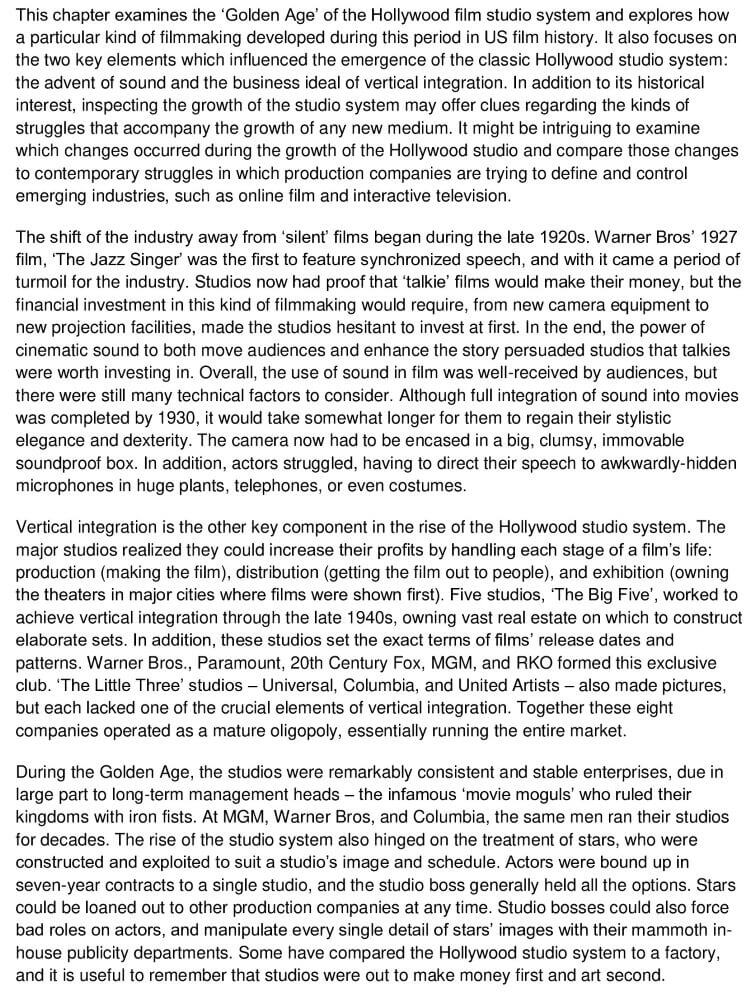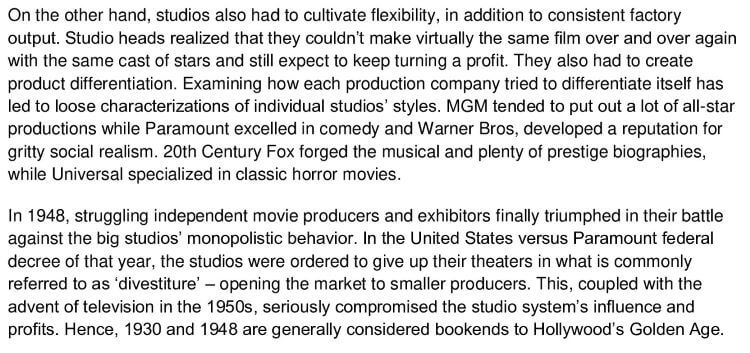The Hollywood Film Industry - IELTS Reading Answers
10 min read
Updated On
-
Copy link
Crack the given test and check your "The Hollywood Film Industry - IELTS Reading answers" now! To boost your preparations, now is the time!
Table of Contents

5 Most Recent IELTS Reading Practice Tests
The Hollywood Film Industry IELTS Reading passage has appeared in a previous IELTS Exam. Since questions can be repeated in the test, these kinds of reading passages are ideal for practice.
Since IELTS Academic Reading is considered the second easiest module of the exam after Listening, try to solve and review the ‘Hollywood Film Industry’ IELTS Reading passage and similar passages to ensure that your reading skills are up to the mark.
Here are the types of questions given in The Hollywood Film Industry IELTS Reading Answers:
- IELTS Reading Matching Headings [Q.14 – Q.19]
- IELTS Reading True/False or Not Given [Q. 20 – Q. 23]
- IELTS Reading Summary Completion [Q. 24 – Q. 26]
The Hollywood Film Industry IELTS Reading Passage
First, go through the reading passage given below. Remember, by solving the IELTS reading practice tests and reviewing the sample reading questions from past IELTS papers on the passage “The Hollywood Film Industry” you can ensure that your Reading skills are up to the mark.
The Hollywood Film Industry


If you want to learn from the best IELTS professionals, consider attending FREE webinars.
Sign up to grab one of the limited seats!
Questions
Now have a look at the questions for the passage, The Hollywood Film Industry Reading Answers and make sure to complete it within 20 minutes using the IELTS Reading keyword techniques.
Questions 14-19
List of Headings
i. The power within each studio
ii. The movie industry adapts to innovation
iii. Contrasts between cinema and other media of the time
iv. The value of studying Hollywood’s Golden Age
v. Distinguishing themselves from the rest of the market
vi. A double attack on film studios’ power
vii. Gaining control of the industry
viii. The top movies of Hollywood’s Golden Age
14 Paragraph A
15 Paragraph B
16 Paragraph C
17 Paragraph D
18 Paragraph E
19 Paragraph F
Questions 20-23
Do the following statements agree with the information given in the Reading Passage?
TRUE if the statement agrees with the information
FALSE if the statement contradicts the information
NOT GIVEN if there is no information on this
20 After The Jazz Singer came out, other studios immediately began making movies with synchronized sound.
21 There were some drawbacks to recording movie actors’ voices in the early 1930s.
22 There was intense competition between actors for contracts with the leading studios.
23 Studios had total control over how their actors were perceived by the public.
Questions 24-26
THE HOLLYWOOD STUDIOS
Throughout its Golden Age, the Hollywood movie industry was controlled by a handful of studios. Using a system known as 24………………………………, the biggest studios not only made movies but handled their distribution and then finally showed them in their theaters. These studios were often run by autocratic bosses – men known as 25…………………………………, who often remained at the head of organizations for decades. However, the domination of the industry by the leading studios came to an end in 1948, when they were forced to open the market to smaller producers – a process known as 26…………………………
The Hollywood Film Industry Reading Answers and Explanations
To have a well-rounded preparation and achieve a better IELTS band score, you need to find out the areas you need to improve after solving the reading passage. Therefore, check the answers of The Hollywood Film Industry Reading Answers given below along with the location and explanation for each answer.
14 Answer: Ⅳ
Question type: Match the headings
Answer location: Paragraph A, lines 1-7
Answer explanation: “This chapter examines the ‘Golden Age’ of the Hollywood film studio system and explores how a particular kind of filmmaking developed during this period in US film history. It also focuses on the two key elements which influenced the emergence of the classic Hollywood studio system: the advent of sound and the business ideal of vertical integration. In addition to its historical interest, inspecting the growth of the studio system may offer clues regarding the kinds of struggles that accompany the growth of any new medium.” These lines throw light on the benefits and takeaways as far as learning about the golden age of Hollywood is concerned, the paradigm shift in the industry, and the transitions that the industry went through in a course of time.
15 Answer: Ⅱ
Question type: Match the headings
Answer location: Paragraph B, lines 1-4
Answer explanation: “The shift of the industry away from ‘silent’ films began during the late 1920s. Warner Bros’ 1927 film, ‘The Jazz Singer’ was the first to feature synchronized speech, and with it came a period of turmoil for the industry. Studios now had proof that ‘talkie’ films would make their money….” These lines suggest the initiation of the adaptation and shift from the conventional silent movies to speech synchronized movies.
16 Answer: Ⅶ
Question type: Match the headings
Answer location: Paragraph C, lines 1-6
Answer explanation: “Vertical integration is the other key component in the rise of the Hollywood studio system. The major studios realized they could increase their profits by handling each stage of a film’s life: production (making the film), distribution (getting the film out to people), and exhibition (owning the theaters in major cities where films were shown first). Five studios, ‘The Big Five’, worked to achieve vertical integration through the late 1940s, owning vast real estate on which to construct elaborate sets.” These lines imply how the studios transitioned into being mighty totalitarian and overweening factors by various means, such as vertical integration. The entire passage C talks about the control and monopoly of the studios.
17 Answer: Ⅰ
Question type: Match the headings
Answer location: Paragraph D, lines 1-6
Answer explanation: “During the Golden Age, the studios were remarkably consistent and stable enterprises, due in large part to long-term management heads – the infamous ‘movie moguls’ who ruled their kingdoms with iron fists. At MGM, Warner Bros, and Columbia, the same men ran their studios for decades. The rise of the studio system also hinged on the treatment of stars, who were constructed and exploited to suit a studio’s image and schedule.” These lines illustrate the powers and control of the prominent studios of that era. The studios not only enjoyed the fame and money of the movies they made, but also the control they had over each of the processes related to their movies and the actors thereof.
18 Answer: Ⅴ
Question type: Match the headings
Answer location: Paragraph E, lines 2-9
Answer explanation: “Studio heads realized that they couldn’t make virtually the same film over and over again with the same cast of stars and still expect to keep turning a profit. They also had to create product differentiation. Examining how each production company tried to differentiate itself has led to loose characterizations of individual studios’ styles. MGM tended to put out a lot of all-star productions while Paramount excelled in comedy and Warner Bros, developed a reputation for gritty social realism. 20th Century Fox forged the musical and a lot of prestige biographies, while Universal specialized in classic horror movies.” These lines make it apparent that the studios of prominence specialized and differentiated themselves into various genres. Some differentiated themselves from the rest of the market by clinging to the genre of comedy while others chose horror or biographies as their genres.
19 Answer: Ⅵ
Question type: Match the headings
Answer location: Paragraph F, lines 1-6
Answer explanation: “In 1948, struggling independent movie producers and exhibitors finally triumphed in their battle against the big studios’ monopolistic behavior. In the United States versus Paramount federal decree of that year, the studios were ordered to give up their theaters in what is commonly referred to as ‘divestiture’ – opening the market to smaller producers. This, coupled with the advent of television in the 1950s, seriously compromised the studio system’s influence and profits.” This suggests that the authority of the movie moguls came to an end in the year 1948 when the process called divestiture coerced them to give up a fair share of the opportunity to the aspiring and budding production houses. Apart from that, the second attack was the advent of television series, which deviated from the popularity of the movies.
20 Answer: False
Question type: True/False/Not given
Answer location: Paragraph B, lines 2-6
Answer explanation: “Warner Bros’ 1927 film, ‘The Jazz Singer’ was the first to feature synchronized speech, and with it came a period of turmoil for the industry. Studios now had proof that ‘talkie’ films would make their money, but the financial investment in this kind of filmmaking would require, from new camera equipment to new projection facilities, made the studios hesitant to invest at first.” This suggests that the moviemakers were not immediately ready to adapt to the changes as far as the inclusion of synchronized speech is concerned. This process of adaptation was rather indecisive at first and the concerned people were rather iffy in this regard.
21 Answer: True
Question type: True/False/Not given
Answer location: Paragraph B, lines 9-13
Answer explanation: “Although full integration of sound into movies was completed by 1930, it would take somewhat longer for them to regain their stylistic elegance and dexterity. The camera now had to be encased in a big, clumsy, immovable soundproof box. In addition, actors struggled, having to direct their speech to awkwardly-hidden microphones in huge plants, telephones, or even costumes.” These lines highlight the cons/drawbacks of the dubbing process of the movie actors. This included hassles in recording the voices, portability of cameras, etc.
22 Answer: Not given
Question type: True/False/Not given
Answer location: N/A
Answer explanation: There is no reference for the competition between the actors in the whole passage.
23 Answer: True
Question type: True/False/Not given
Answer location: Paragraph D, lines 6-10
Answer explanation: “Actors were bound up in seven-year contracts to a single studio, and the studio boss generally held all the options. Stars could be loaned out to other production companies at any time. Studio bosses could also force bad roles on actors, and manipulate every single detail of stars’ images with their mammoth in-house publicity departments.” These lines make it quite clear that the studios had all the authority from distributing movies to loaning the stars to assigning them the roles- good/bad- irrespective of the actors’ demands. Hence, the statement is true.
24 Answer: Vertical integration
Question type: Summary completion
Answer location: Paragraph C, lines 2-7
Answer explanation: “The major studios realized they could increase their profits by handling each stage of a film’s life: production (making the film), distribution (getting the film out to people), and exhibition (owning the theaters in major cities where films were shown first). Five studios, ‘The Big Five’, worked to achieve vertical integration through the late 1940s, owning vast real estate on which to construct elaborate sets. In addition, these studios set the exact terms of films’ release dates and patterns.” These lines suggest that through the process of vertical integration, the studios who had repressive and autocratic control took every process of a movie released under the name of their studios under their authority.
25 Answer: Movie moguls
Question type: Summary completion
Answer location: Paragraph D, lines 1-4
Answer explanation: “During the Golden Age, the studios were remarkably consistent and stable enterprises, due in large part to long-term management heads – the infamous ‘movie moguls’ who ruled their kingdoms with iron fists. At MGM, Warner Bros, and Columbia, the same men ran their studios for decades.” These lines suggest that the people who were exercising their control over the movies and the stars who were cast in the movies were called movie moguls. These were those people who were totalitarian and authoritarian in nature and execution of their powers.
26 Answer: Divestiture
Question type: Summary completion
Answer location: Paragraph F, lines 2-5
Answer explanation: “In the United States versus Paramount federal decree of that year, the studios were ordered to give up their theaters in what is commonly referred to as ‘divestiture’ – opening the market to smaller producers.” This suggests that in the year 1948, the hegemony and monopoly of these studios came to a halt after they were forced to go through the divestiture- a process where the studios were forced to open markets for the smaller aspiring movie studios.
Do you have a book with everything from tips, strategies to Practice Tests for IELTS Academic Reading?
Check out the IELTS Reading Academic Test Guide!
Boost Your Reading Skills Stand Out with IELTSMaterial
Boosting your reading skills isn't just about just reading a passage. It's also about grasping the information clearly and having to reply back with good IELTS grammar. Doing this all alone by practising test papers might be hard. So, you can get help from our IELTS experts or attend our FREE webinars to learn tips and improve your reading skills for the IELTS exam!
Check More IELTS Reading Answers
Practice IELTS Reading based on question types

Free online IELTS Academic Reading practice test
Explore other Reading Topics

Kasturika Samanta

Kasturika Samanta

Kasturika Samanta

Kasturika Samanta
Recent Articles

Nehasri Ravishenbagam

Haniya Yashfeen

Haniya Yashfeen

Haniya Yashfeen




Post your Comments